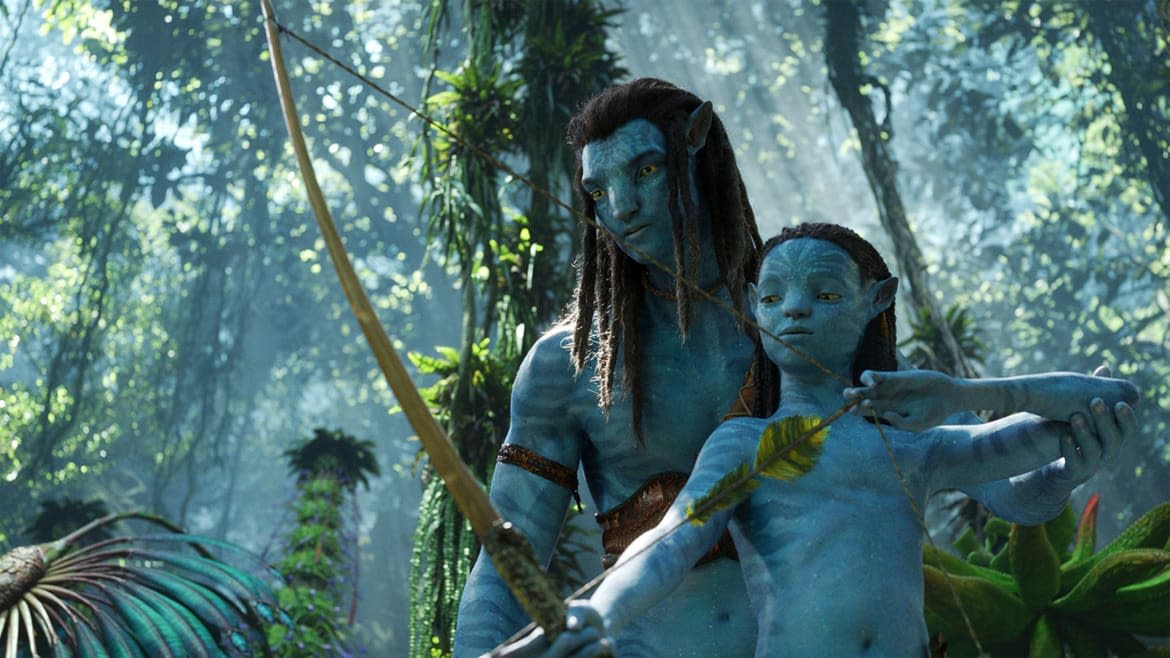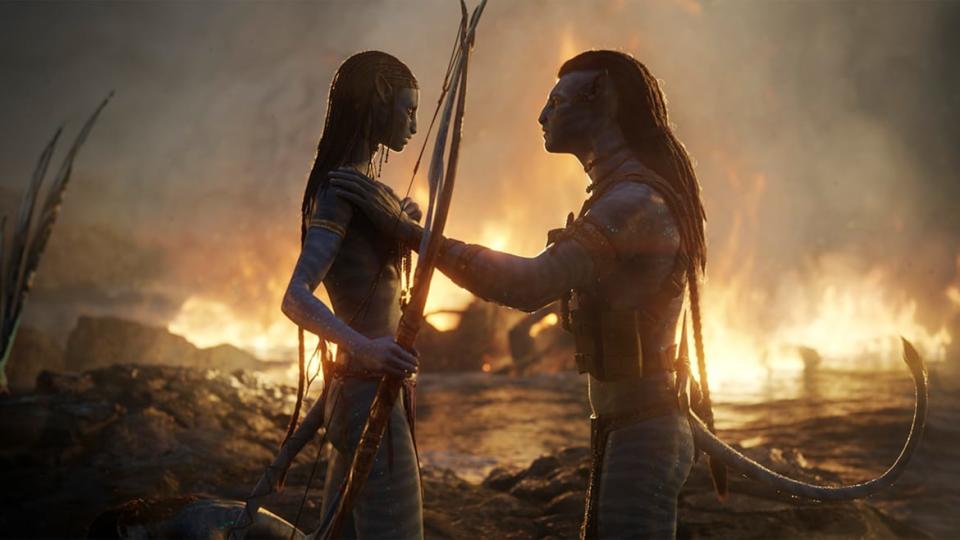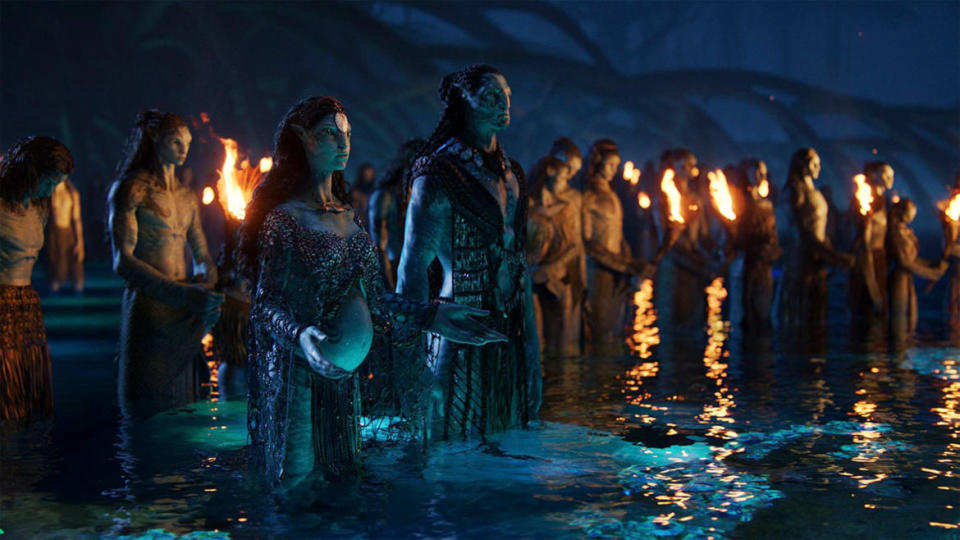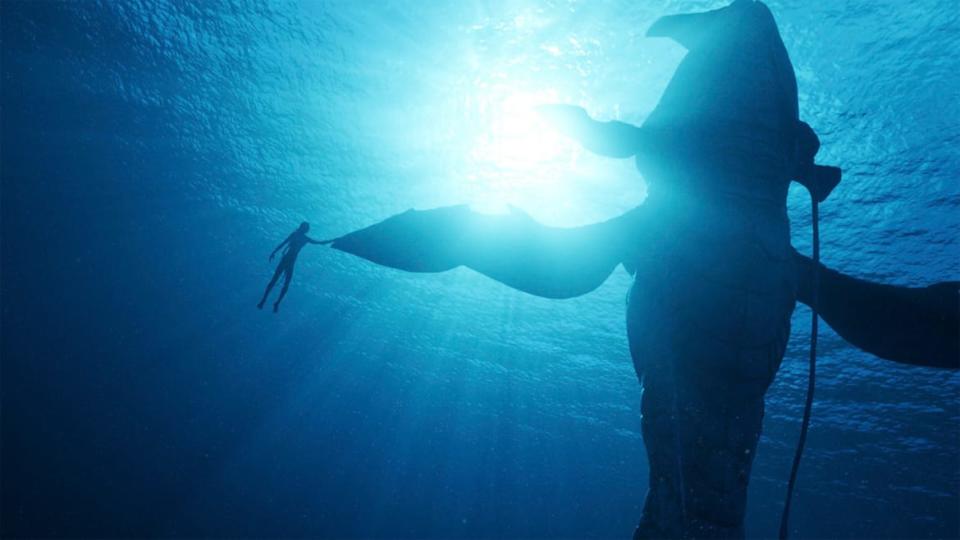Why ‘Avatar: The Way of Water’ Isn’t Worth the 13-Year Wait

- Oops!Something went wrong.Please try again later.
- Oops!Something went wrong.Please try again later.
James Cameron intended Avatar to usher in a grand new age of 3D. Yet 13 years after the movie became the all-time box-office champ, that glasses-required revolution turned out to be merely a fad. For all its fiscal success, Avatar’s cultural and cinematic impact remains shockingly small, influencing few other works and inspiring little lasting critical or public adoration; its prime legacy, in fact, appears to be simply augmenting blockbusters’ reliance on CG spectacle above all other concerns. It’s the king of the movie world that no one seems to care about, much less ardently love.
It's in that version of 2022—the one in which Avatar is simply an artifact—that the writer/director returns with Avatar: The Way of Water: a long-discussed follow-up (and the first of four planned sequels, some of which have already been shot) that aims to revive the franchise and solidify its position as the money-maker to beat them all.
Underestimating Avatar’s financial potential would be a fool’s game. But creatively speaking, The Way of Water (Dec. 16, in theaters) is of a piece with its predecessor, a would-be epic of boundary-pushing digi-grandeur in service of Pocahontas-style us-vs-them mush. There’s something absurdly ironic about Cameron continuing to peddle fantasies about nature-attuned, highly spiritual, indigenous people gallantly slaying the forces of advanced civilization via a wholly artificial affair that—produced by Disney with the priciest cine-gadgets available—is literally the Most Modern Movie Ever.
Alas, anyone hoping for such self-awareness, or even the slightest sense of humor, will be sorely disappointed. The Oscar winner’s latest does nothing if not take itself oh-so-seriously, be it with regards to its endless barrage of sound and fury or its puffed-up narrative about Pandora’s Na’vi resuming their good fight against villainous humanity.
There’s an incredible amount of exacting detail crammed into Cameron’s frame, and that extends to the many aquatic sequences found throughout The Way of Water. Cameron’s battalion of effects artists do a superb job recreating the ebb and flow of water. However, as with his characters’ swift and bounding movements, there’s something dissonantly artificial about his imagery. The director keeps pushing closer and closer to photorealism and yet coming up just short; the more he strives to meld the fake and the authentic, the more the contrast shows. There’s a persistent, evident disconnect between his animated and live-action figures and environments.

It’s an unreality heightened not only by his use of 3D—adding depth to his out-there sights, even if it loses its impact after 30 minutes—but also by his misbegotten decision to often shoot at 48fps. Such high frame rate gimmickry gives everything a phony motion-smoothing quality that calls further attention to the innovative methods at play; worse, Cameron doesn’t use it consistently, sometimes flip-flopping back to the standard 24fps within a given scene, which exacerbates the material’s aesthetic wonkiness.
The show-offery is off-the-charts, with Cameron insisting that viewers be dutifully awed by his every gorgeously crafted piece of alien foliage, fantastical marine inhabitant, rain drop cascading down Na’vi skin, and ocean swell. But it’s a pushiness that sabotages his attempts at conjuring genuine lyricism, beauty, or grace.
Though the film may be the pinnacle of big-screen CGI, that only gets its so far, especially because the Na’vi—the series’ tall, blue, slender, feline-humanoid protagonists—are still weird, ungainly creations. There’s a reason heroes Jake Sully (Sam Worthington) and Neytiri (Zoe Saldaña) aren’t cultural icons, and it has much to do with their physical unattractiveness, which also characterizes Pandora’s outlandishly color-streaked and underwhelming, faux-Heavy Metal dino-beasts.
The ‘Avatar’ Sequels Are Pop Culture’s Biggest Joke
The Way of Water looks expensive and groundbreaking, while simultaneously feeling forced and without a single memorable vision. That’s a serious shortcoming given that its plot is a leaden chore marked by familiar conflict, tedious “world-building,” and Cameron’s typically clunky dialogue. More than a decade after the last film, Jake and Neytiri have had three biological kids: sons Neteyam (Jamie Flatters) and Lo’ak (Britain Dalton), and daughter Tuk (Trinity Jo-Li Bliss).
They’ve also adopted another, Kiri (Sigourney Weaver), a girl who’s the child of Dr. Grace Augustine (also Weaver), who perished at the conclusion of Avatar. The specifics of Kiri’s parentage are both a mystery and wholly obvious, and her Christ-like status combines with a late Jonah and the Whale-esque bit to lend the proceedings some faint biblical flavor. Mostly, though, Cameron indulges in earnest paeans to family (“Sullys Stick Together!”) and to the magical wondrousness of nature.
As before, the Na’vi are Native American proxies that pray to spirit trees, chant in solemn rituals, and interface with their animal brethren via fiber optic-grade hair braids. The Way of Water’s prime novelty is a Māori-ish community of water-centric Na’vi, to whom Jake turns for help to protect his family from Colonel Miles Quaritch (Stephen Lang). In the first movie, Quaritch died at the hands (or, more specifically, arrows) of Neytiri, and has now been resurrected, along with his Marine lackies, as a Na’vi. His mission is to hunt down and kill Jake, now a famed rebel causing trouble for humans as they try to transform Pandora into a new planetary home.

A near-fatal run-in between Miles and Jake’s offspring convinces Jake that the family must relocate. They’re not exactly welcomed with open arms by island leaders Tonowari (Cliff Curtis) and Ronal (Kate Winslet), and his brood initially clashes with that duo’s children. Nonetheless, they gradually acclimate, all as Miles attempts to hunt his prey by going native with the aid of Spider (Jack Champion), a feral human teen who happens to be Miles’ son.
The Way of Water drags itself into gear and then spends its middle section focusing on Jake’s kids—particularly Kiri, who has a not-so-beguiling connection to the Na’vi deity Eywa, and Lo’ak, who’s always in Jake’s doghouse for disobedience and/or putting his siblings in danger. Lo’ak eventually strikes up a bond with one of the region’s alien whales.
As we learn from a kind biologist (Jemaine Clement) who’s collaborating with a dastardly whale-hunter, these mammoth, multi-eyed mammals are smarter, more artistic, and more spiritual than humans, and they share stories and sing songs with the Na’vi. Cameron expends plentiful energy on seascapes of these goliaths frolicking and moan-chatting with Lo’ak (replete with subtitles!) and, later, smashing man’s boats and ships, employing reams of computer code to italicize the film’s anti-industrial, eco-friendly message.

Cameron sincerely cares about Jake’s clan and their wildlife buddies, but they’re a doggedly two-dimensional and clichéd bunch (stout dad! Furious mom! Favored older son! Cute tyke!), embodied with minimal personality. Worthington is a charisma vacuum, Saldaña primarily cries and screams in anguish, and the rest deliver stilted turns beneath layers of motion-capture-assisted effects.
But these effects are most captivating when racing into battle and squaring off against imposing Avatar adversaries, and in the film’s back half, Cameron shrewdly sets aside the particulars of his paint-by-numbers melodrama for all-out warfare. Few directors are as adept at crafting gargantuan set pieces and intimate one-on-one showdowns with such muscularity and lucidity, and The Way of Water peaks in virtuosic fashion, nodding to virtually every prior Cameron effort (The Abyss, Terminator 2: Judgment Day, Titanic) along the way.
Edie Falco thanklessly barks exposition in fatigues, a scientist randomly reveals that he possesses the key to eternal life, and the finale resorts to cheap bathos before setting up forthcoming sequels. Whenever it’s not losing itself in kinetic mayhem, The Way of Water is interminable and full of itself—and ultimately, that turns out to be most of the time. In the first of his many functional voiceovers, Jake intones, “The most dangerous thing about Pandora is that you may come to love her too much.” That’s clearly true for Cameron, but he should speak for himself.
Get the Daily Beast's biggest scoops and scandals delivered right to your inbox. Sign up now.
Stay informed and gain unlimited access to the Daily Beast's unmatched reporting. Subscribe now.

